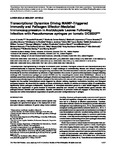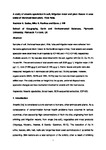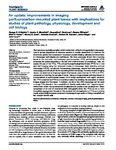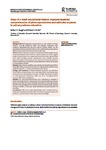Transcriptional Dynamics Driving MAMP-Triggered Immunity and Pathogen Effector-Mediated Immunosuppression in Arabidopsis Leaves Following Infection with <i>Pseudomonas syringae</i> pv tomato DC3000
| dc.contributor.author | Lewis, LA | |
| dc.contributor.author | Polanski, K | |
| dc.contributor.author | de Torres-Zabala, M | |
| dc.contributor.author | Jayaraman, Siddharth | |
| dc.contributor.author | Bowden, L | |
| dc.contributor.author | Camelo, António | |
| dc.contributor.author | Penfold, Christopher | |
| dc.contributor.author | Jenkins, DJ | |
| dc.contributor.author | Hill, C | |
| dc.contributor.author | Baxter, L | |
| dc.contributor.author | KULASEKARAN, SATISH | |
| dc.contributor.author | Truman, W | |
| dc.contributor.author | Littlejohn, George | |
| dc.contributor.author | Prusinska, J | |
| dc.contributor.author | Mead, Andrew | |
| dc.contributor.author | Steinbrenner, Jens | |
| dc.contributor.author | Hickman, R | |
| dc.contributor.author | Rand, David | |
| dc.contributor.author | Wild, DL | |
| dc.contributor.author | Ott, S | |
| dc.contributor.author | Buchanan-Wollaston, V | |
| dc.contributor.author | Smirnoff, Nicholas | |
| dc.contributor.author | Beynon, J | |
| dc.contributor.author | Denby, Katherine | |
| dc.contributor.author | Grant, Murray | |
| dc.date.accessioned | 2017-05-24T19:09:52Z | |
| dc.date.available | 2017-05-24T19:09:52Z | |
| dc.date.issued | 2015-11 | |
| dc.identifier.issn | 1040-4651 | |
| dc.identifier.issn | 1532-298X | |
| dc.identifier.uri | http://hdl.handle.net/10026.1/9338 | |
| dc.description.abstract |
Transcriptional reprogramming is integral to effective plant defense. Pathogen effectors act transcriptionally and posttranscriptionally to suppress defense responses. A major challenge to understanding disease and defense responses is discriminating between transcriptional reprogramming associated with microbial-associated molecular pattern (MAMP)-triggered immunity (MTI) and that orchestrated by effectors. A high-resolution time course of genome-wide expression changes following challenge with Pseudomonas syringae pv tomato DC3000 and the nonpathogenic mutant strain DC3000hrpA- allowed us to establish causal links between the activities of pathogen effectors and suppression of MTI and infer with high confidence a range of processes specifically targeted by effectors. Analysis of this information-rich data set with a range of computational tools provided insights into the earliest transcriptional events triggered by effector delivery, regulatory mechanisms recruited, and biological processes targeted. We show that the majority of genes contributing to disease or defense are induced within 6 h postinfection, significantly before pathogen multiplication. Suppression of chloroplast-associated genes is a rapid MAMP-triggered defense response, and suppression of genes involved in chromatin assembly and induction of ubiquitin-related genes coincide with pathogen-induced abscisic acid accumulation. Specific combinations of promoter motifs are engaged in fine-tuning the MTI response and active transcriptional suppression at specific promoter configurations by P. syringae. | |
| dc.format.extent | 3038-3064 | |
| dc.format.medium | Print-Electronic | |
| dc.language | en | |
| dc.language.iso | eng | |
| dc.publisher | Oxford University Press (OUP) | |
| dc.subject | Arabidopsis | |
| dc.subject | Base Sequence | |
| dc.subject | Chromatin | |
| dc.subject | Gene Expression Profiling | |
| dc.subject | Gene Expression Regulation, Plant | |
| dc.subject | Gene Ontology | |
| dc.subject | Gene Regulatory Networks | |
| dc.subject | Genes, Plant | |
| dc.subject | Immunosuppression Therapy | |
| dc.subject | Molecular Sequence Data | |
| dc.subject | Nucleotide Motifs | |
| dc.subject | Pathogen-Associated Molecular Pattern Molecules | |
| dc.subject | Plant Diseases | |
| dc.subject | Plant Immunity | |
| dc.subject | Plant Leaves | |
| dc.subject | Promoter Regions, Genetic | |
| dc.subject | Pseudomonas syringae | |
| dc.subject | Transcription Factors | |
| dc.subject | Transcription, Genetic | |
| dc.title | Transcriptional Dynamics Driving MAMP-Triggered Immunity and Pathogen Effector-Mediated Immunosuppression in Arabidopsis Leaves Following Infection with <i>Pseudomonas syringae</i> pv tomato DC3000 | |
| dc.type | journal-article | |
| dc.type | Journal Article | |
| dc.type | Research Support, Non-U.S. Gov't | |
| plymouth.author-url | https://www.webofscience.com/api/gateway?GWVersion=2&SrcApp=PARTNER_APP&SrcAuth=LinksAMR&KeyUT=WOS:000368295800005&DestLinkType=FullRecord&DestApp=ALL_WOS&UsrCustomerID=11bb513d99f797142bcfeffcc58ea008 | |
| plymouth.issue | 11 | |
| plymouth.volume | 27 | |
| plymouth.publication-status | Published | |
| plymouth.journal | The Plant Cell | |
| dc.identifier.doi | 10.1105/tpc.15.00471 | |
| plymouth.organisational-group | /Plymouth | |
| plymouth.organisational-group | /Plymouth/Faculty of Science and Engineering | |
| plymouth.organisational-group | /Plymouth/Faculty of Science and Engineering/School of Biological and Marine Sciences | |
| plymouth.organisational-group | /Plymouth/REF 2021 Researchers by UoA | |
| plymouth.organisational-group | /Plymouth/REF 2021 Researchers by UoA/UoA06 Agriculture, Veterinary and Food Science | |
| plymouth.organisational-group | /Plymouth/Users by role | |
| plymouth.organisational-group | /Plymouth/Users by role/Academics | |
| dc.publisher.place | England | |
| dcterms.dateAccepted | 2015-10-22 | |
| dc.identifier.eissn | 1532-298X | |
| dc.rights.embargoperiod | No embargo | |
| rioxxterms.versionofrecord | 10.1105/tpc.15.00471 | |
| rioxxterms.licenseref.uri | http://www.rioxx.net/licenses/all-rights-reserved | |
| rioxxterms.licenseref.startdate | 2015-11 | |
| rioxxterms.type | Journal Article/Review |





